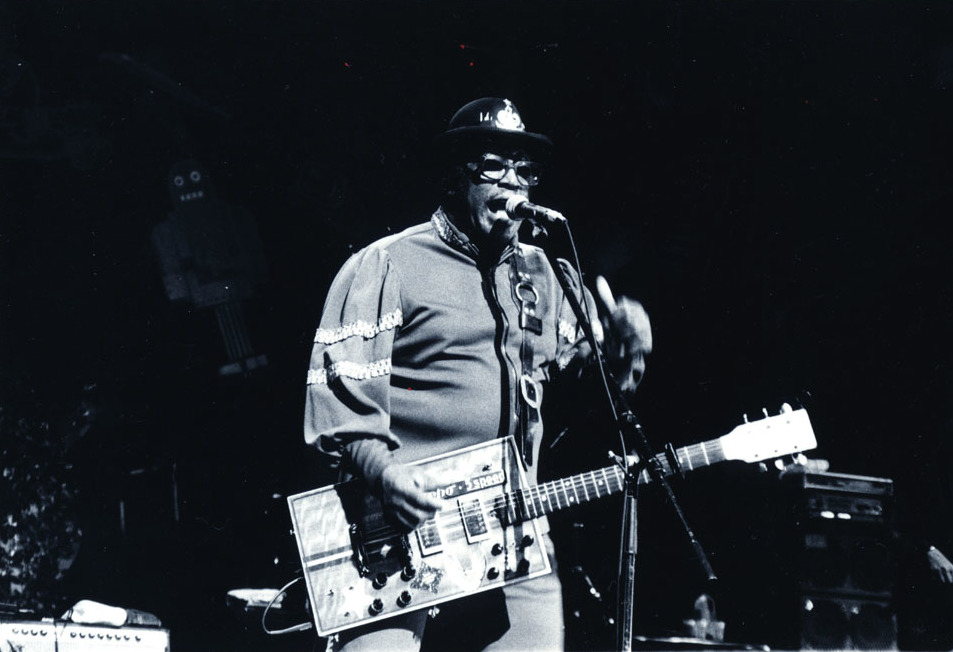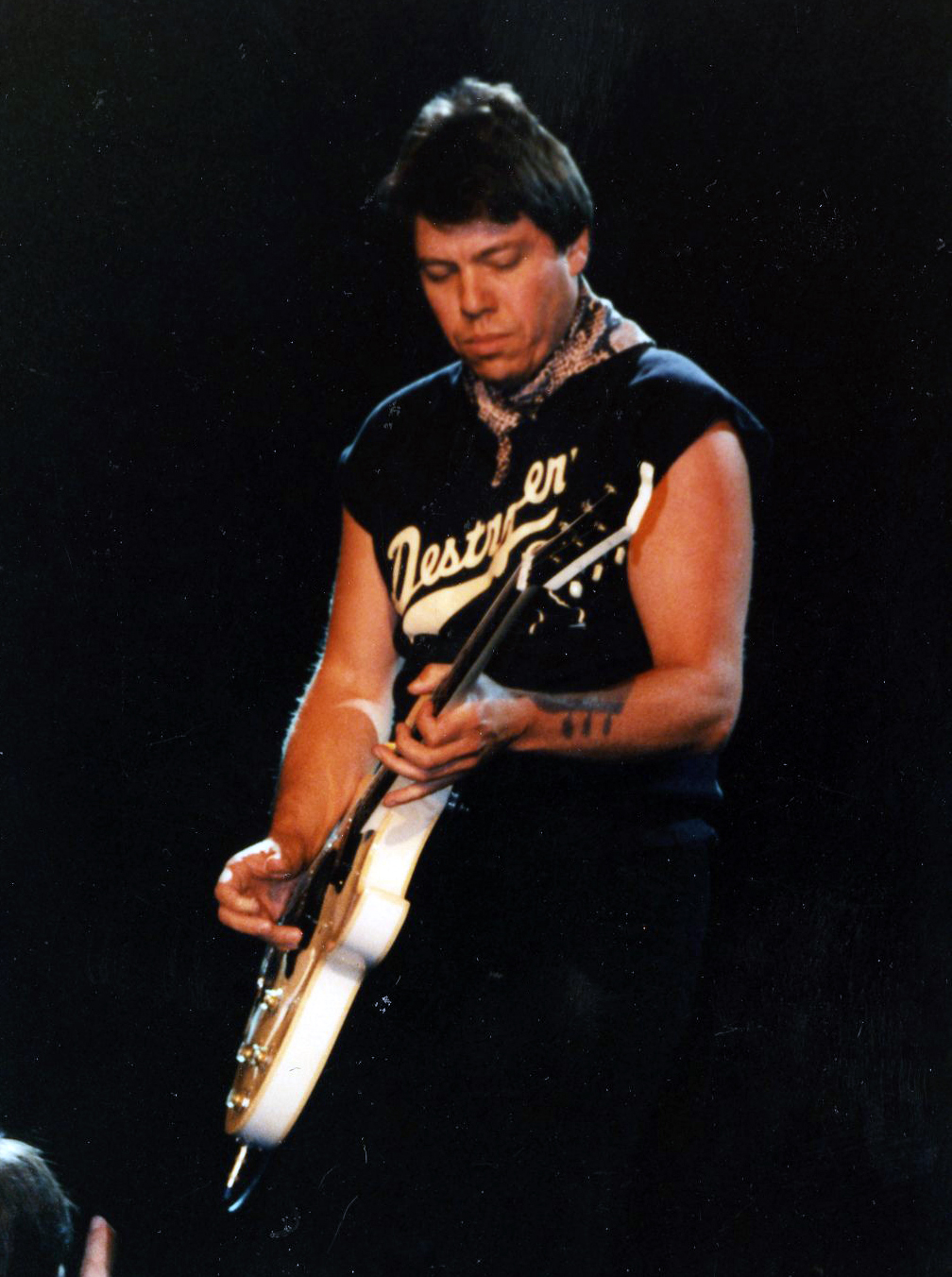|
Bo Diddley
Ellas Otha Bates McDaniel (December 30, 1928 – June 2, 2008), known professionally as Bo Diddley, was an American guitarist and singer who played a key role in the transition from the blues to rock and roll. He influenced many artists, including Buddy Holly, Elvis Presley, The Beatles, The Rolling Stones, The Animals, George Thorogood, Syd Barrett, and The Clash. His use of African rhythms and a signature beat, a simple five- accent hambone rhythm, is a cornerstone of hip hop, rock, and pop music. In recognition of his achievements, he was inducted into the Rock and Roll Hall of Fame in 1987, the Blues Hall of Fame in 2003, and the Rhythm and Blues Music Hall of Fame in 2017. He received a Lifetime Achievement Award from the Rhythm and Blues Foundation and the Grammy Lifetime Achievement Award. Diddley is also recognized for his technical innovations, including his use of tremolo and reverb effects to enhance the sound of his distinctive rectangular-shaped guitars. Early ... [...More Info...] [...Related Items...] OR: [Wikipedia] [Google] [Baidu] |
McComb, Mississippi
McComb is a city in Pike County, Mississippi, United States. The city is approximately south of Jackson. As of the 2010 census, the city had a total population of 12,790. It is the principal city of the McComb, Mississippi Micropolitan Statistical Area. History 19th century McComb was founded in 1872 after Henry Simpson McComb of the New Orleans, Jackson and Great Northern Railroad, a predecessor of the Illinois Central Railroad (now part of the Canadian National Railway), decided to move the railroad's maintenance shops away from New Orleans, Louisiana, to avoid the attractions of that city's bars. The railroad purchased land in Pike County. Three nearby communities, Elizabethtown, Burglund, and Harveytown, agreed to consolidate to form this town. Main Street developed with the downtown's shops, attractions, and business. 20th century The rail center in McComb was one of flashpoints in the violent Illinois Central shopmen's strike of 1911. Riots took place here that result ... [...More Info...] [...Related Items...] OR: [Wikipedia] [Google] [Baidu] |
George Thorogood
George Lawrence Thorogood (born February 24, 1950) is an American musician, singer and songwriter from Wilmington, Delaware. His "high-energy boogie-blues" sound became a staple of 1980s rock radio, with hits like his original songs "Bad to the Bone" and "I Drink Alone". He has also helped to popularize older songs by American icons, such as " Move It on Over", " Who Do You Love?", and "House Rent Blues/One Bourbon, One Scotch, One Beer". With his band, the Delaware Destroyers, Thorogood has released over 20 albums, two of which have been certified Platinum and six have been certified Gold. He has sold 15 million records worldwide. Thorogood and his band continue to tour extensively and in 2014 the band celebrated their 40th anniversary of performing. Music career Thorogood began his career as a solo acoustic performer in the style of Robert Johnson and Elmore James after being inspired in 1970 by a John P. Hammond concert. In 1973, he formed a band, the Delaware Destroyers, wi ... [...More Info...] [...Related Items...] OR: [Wikipedia] [Google] [Baidu] |
Blues Hall Of Fame
The Blues Hall of Fame is a music museum located at 421 S. Main Street in Memphis, Tennessee. Initially, the "Blues Hall of Fame" was not a physical building, but a listing of people who have significantly contributed to blues music. Started in 1980 by the Blues Foundation The Blues Foundation is an American nonprofit corporation, headquartered in Memphis, Tennessee, that is affiliated with more than 175 blues organizations from various parts of the world. Founded in 1980, a 25-person board of directors governs the ..., it honors people who have performed, recorded, or documented blues. The actual building for the hall opened to the public on May 8, 2015. Inductees Performers Non Performers Literature Albums Singles/album tracks References * External linksBlues Foundation official website {{authority control Blues music awards Music halls of fame Halls of fame in Tennessee Awards established in 1980 Music museums in Tennessee Museums in Mem ... [...More Info...] [...Related Items...] OR: [Wikipedia] [Google] [Baidu] |
Rock And Roll Hall Of Fame
The Rock and Roll Hall of Fame (RRHOF), sometimes simply referred to as the Rock Hall, is a museum A museum ( ; plural museums or, rarely, musea) is a building or institution that cares for and displays a collection of artifacts and other objects of artistic, cultural, historical, or scientific importance. Many public museums make thes ... and hall of fame located in downtown Cleveland, Ohio, United States, on the shore of Lake Erie. The museum documents the history of rock music and the artists, producers, engineers, and other notable figures who have influenced its development. The Rock and Roll Hall of Fame Foundation was established on April 20, 1983, by Ahmet Ertegun, founder and chairman of Atlantic Records. After a long search for the right city, Cleveland was chosen in 1986 as the Hall of Fame's permanent home. Architect I. M. Pei designed the new museum, and it was dedicated on September 1, 1995. Rock and Roll Hall of Fame Foundation The RRHOF Foundation was ... [...More Info...] [...Related Items...] OR: [Wikipedia] [Google] [Baidu] |
Rolling Stone
''Rolling Stone'' is an American monthly magazine that focuses on music, politics, and popular culture. It was founded in San Francisco, San Francisco, California, in 1967 by Jann Wenner, and the music critic Ralph J. Gleason. It was first known for its coverage of rock music and political reporting by Hunter S. Thompson. In the 1990s, the magazine broadened and shifted its focus to a younger readership interested in youth-oriented television shows, film actors, and popular music. It has since returned to its traditional mix of content, including music, entertainment, and politics. The first magazine was released in 1967 and featured John Lennon on the cover and was published every two weeks. It is known for provocative photography and its cover photos, featuring musicians, politicians, athletes, and actors. In addition to its print version in the United States, it publishes content through Rollingstone.com and numerous international editions. Penske Media Corporation is the c ... [...More Info...] [...Related Items...] OR: [Wikipedia] [Google] [Baidu] |
Pop Music
Pop music is a genre of popular music that originated in its modern form during the mid-1950s in the United States and the United Kingdom. The terms ''popular music'' and ''pop music'' are often used interchangeably, although the former describes all music that is popular and includes many disparate styles. During the 1950s and 1960s, pop music encompassed rock and roll and the youth-oriented styles it influenced. ''Rock'' and ''pop'' music remained roughly synonymous until the late 1960s, after which ''pop'' became associated with music that was more commercial, ephemeral, and accessible. Although much of the music that appears on record charts is considered to be pop music, the genre is distinguished from chart music. Identifying factors usually include repeated choruses and hooks, short to medium-length songs written in a basic format (often the verse-chorus structure), and rhythms or tempos that can be easily danced to. Much pop music also borrows elements from other styles ... [...More Info...] [...Related Items...] OR: [Wikipedia] [Google] [Baidu] |
Rock Music
Rock music is a broad genre of popular music that originated as " rock and roll" in the United States in the late 1940s and early 1950s, developing into a range of different styles in the mid-1960s and later, particularly in the United States and United Kingdom.W. E. Studwell and D. F. Lonergan, ''The Classic Rock and Roll Reader: Rock Music from its Beginnings to the mid-1970s'' (Abingdon: Routledge, 1999), p.xi It has its roots in 1940s and 1950s rock and roll, a style that drew directly from the blues and rhythm and blues genres of African-American music and from country music. Rock also drew strongly from a number of other genres such as electric blues and folk, and incorporated influences from jazz, classical, and other musical styles. For instrumentation, rock has centered on the electric guitar, usually as part of a rock group with electric bass guitar, drums, and one or more singers. Usually, rock is song-based music with a time signature using a verse–chorus form, ... [...More Info...] [...Related Items...] OR: [Wikipedia] [Google] [Baidu] |
Clave (rhythm)
The clave (; ) is a rhythmic pattern used as a tool for temporal organization in Cuban music. In Spanish, ''clave'' literally means key, clef, code, or keystone. It is present in a variety of genres such as Abakuá music, rumba, conga, son, mambo, salsa, songo, timba and Afro-Cuban jazz. The five-stroke clave pattern represents the structural core of many Cuban rhythms. The clave pattern originated in sub-Saharan African music traditions, where it serves essentially the same function as it does in Cuba. In ethnomusicology, clave is also known as a ''key pattern'', ''guide pattern'', ''phrasing referent'', ''timeline'', or ''asymmetrical timeline''. The clave pattern is also found in the African diaspora music of Haitian Vodou drumming, Afro-Brazilian music, African-American music, Louisiana Voodoo drumming, and Afro-Uruguayan music (candombe). The clave pattern (or hambone, as it is known in the United States) is used in North American popular music as a rhythmic motif or si ... [...More Info...] [...Related Items...] OR: [Wikipedia] [Google] [Baidu] |
Accent (music)
In music, an accent is an emphasis, stress, or stronger attack placed on a particular note or set of notes, or chord, either as a result of its context or specifically indicated by an accent mark. Accents contribute to the articulation and prosody of a performance of a musical phrase. Accents may be written into a score or part by a composer or added by the performer as part of his or her interpretation of a musical piece. Compared to surrounding notes: * A ''dynamic accent'' or ''stress accent'' is an emphasis using louder sound or a stronger sound, typically most pronounced on the attack of the sound. * A ''tonic accent'' is an emphasis on notes by virtue of being higher in pitch as opposed to higher in volume. * An ''agogic accent'' is an emphasis by virtue of being longer in duration. Accents which do not correspond to the stressed beats of the prevailing meter are said to be syncopated. For example, in common time, also called 4/4, the most common metre in popular music, ... [...More Info...] [...Related Items...] OR: [Wikipedia] [Google] [Baidu] |
Bo Diddley Beat
The Bo Diddley beat is a syncopated musical rhythm that is widely used in rock and roll and pop music. The beat is named after rhythm and blues musician Bo Diddley, who introduced and popularized the beat with his self-titled debut single, "Bo Diddley", in 1955. Music educator and author Michael Campbell describes the Bo Diddley beat as: History and composition The Bo Diddley beat is a variation of the 3-2 clave, one of the most common bell patterns found in Afro-Cuban music that has been traced to sub-Saharan African music traditions. It is also akin to the rhythmic pattern known as " shave and a haircut, two bits", that has been linked to Yoruba drumming from West Africa. A folk tradition called " hambone", a style used by street performers who play out the beat by slapping and patting their arms, legs, chest, and cheeks while chanting rhymes has also been suggested. According to musician and author Ned Sublette, "In the context of the time, and especially those maracas e ... [...More Info...] [...Related Items...] OR: [Wikipedia] [Google] [Baidu] |
Music Of Africa
Given the vastness of the African continent, its music is diverse, with regions and nations having many distinct musical traditions. African music includes the genres amapiano, Jùjú, Fuji, Afrobeat, Highlife, Makossa, Kizomba, and others. The music and dance of the African diaspora, formed to varying degrees on African musical traditions, include American music like Dixieland jazz, blues, jazz, and many Caribbean genres, such as calypso (see kaiso) and soca. Latin American music genres such as cumbia, conga, rumba, son cubano, salsa music, bomba, samba and zouk were founded on the music of enslaved Africans, and have in turn influenced African popular music. Like the music of Asia, India and the Middle East, it is a highly rhythmic music. The complex rhythmic patterns often involving one rhythm played against another to create a polyrhythm. The most common polyrhythm plays three beats on top of two, like a triplet played against straight notes. Sub-Saharan African mus ... [...More Info...] [...Related Items...] OR: [Wikipedia] [Google] [Baidu] |










